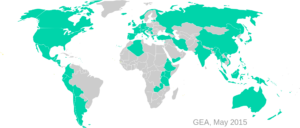We can imagine Planet Earth to be a boiled potato. It has a modest temperature at the outside but at the core it is boiling hot. This heat that is stored inside the planet is called Geothermal Energy. Because of the difference in temperature between the core of the planet and its surface there is a conduction of thermal energy to the surface. Hot springs are a visible outcome of this. Groundwater is heated up by geothermal energy and rises from Earth`s crust. Volcanoes also show us the immense heat that is stored inside the earth.
We can either use Geothermal Energy directly for heating or we can generate electricity from it.
Geothermal Electricity
In simple terms, the geothermal energy heats up water or a different liquid to its boiling point. Rising steam is used to turn a turbine, the movement of which generates energy. After it has done its job the water is cooled and led back to the heat source so it can be used again. Like this a sustainable cycle is established. In order to get to the hot geothermal resources big installations are needed that dig deep into the ground. Therefore, it is only cost-effective at some sites and if used on big scale.
Geothermal power stations use different technologies:
Dry Steam Power Stations are the oldest design. It requires a natural source of geothermal steam coming to the surface which is quite hard to find. | Flash Steam Power Stations are the most common type currently in operation. A source of very hot water (at least 180°) is needed some of which is boiled into steam. | Binary Cycle Power Stations are a new development. Here water of moderate temperature (around 60°) is enough. The water is used to heat a different fluid with a lower boiling point so that its steam turns the turbine. |
More common than geothermal electricity generation is geothermal heating where the thermal energy is used directly for heating of homes, greenhouses, fisheries or industrial processes. These applications allow to make use of geothermal resources on much smaller scale and at a wider range of sites.
The Earth’s geothermal resources are theoretically more than adequate to cover humanity’s energy needs. However, only a few resources can be exploited cost-effectively. Historically, generation of geothermal power was limited to tectonic plate boundaries. Recent technological developments allow to exploit a wider range of geothermal resources but digging and installation of deep geothermal wells is still very expensive.[1] Depending on different factors like technology, energy prices and subsidies it is expected that geothermal power and heating has got the potential to meet 3-5% of global demand by 2050.
There are good geothermal resources in Southern and East Africa along the Great Rift Valley, one of the hottest geothermal zones in the world. Malawi is also located within this area.
Geothermal electricity generation is currently used in 24 countries. However, in total more countries take advantage of geothermal energy as 70 countries have installations for geothermal heating.

The high capital costs are the main factor keeping countries from adopting geothermal electricity generation. Besides the digging and the actual construction there are more costs connected to geothermal power plants such as risk mitigation, maintenance and transmission-network. Another issue is associated uncertainties like the impact the drilling will have on the stability of the land or the amount of electricity that will be generated.
The majority of geothermal electricity is generated in the United States, but Kenya is also among the leaders in geothermal power and generates more than 15% percent of its electricity from geothermal sources. It was the first African country to install geothermal power plants and is now considered the main hub of the African continent in terms of geothermal technology capacity building. Kenya plans to extend its geothermal capacity and other East-African countries like Tanzania and Ethiopia follow up as the high potential of the Great Rift Valley makes it cost-effective.
Despite its favourable resources Malawi does not generate geothermal power so far. As major barriers the absence of both financial and technical capital and the lack of governmental leadership towards the use of the geothermal resources can be named. However, there are recent plans for the construction of a geothermal power plant.
Keep yourself updated on any relevant news related to renewable energies on the platform Conrema.org! 😊
